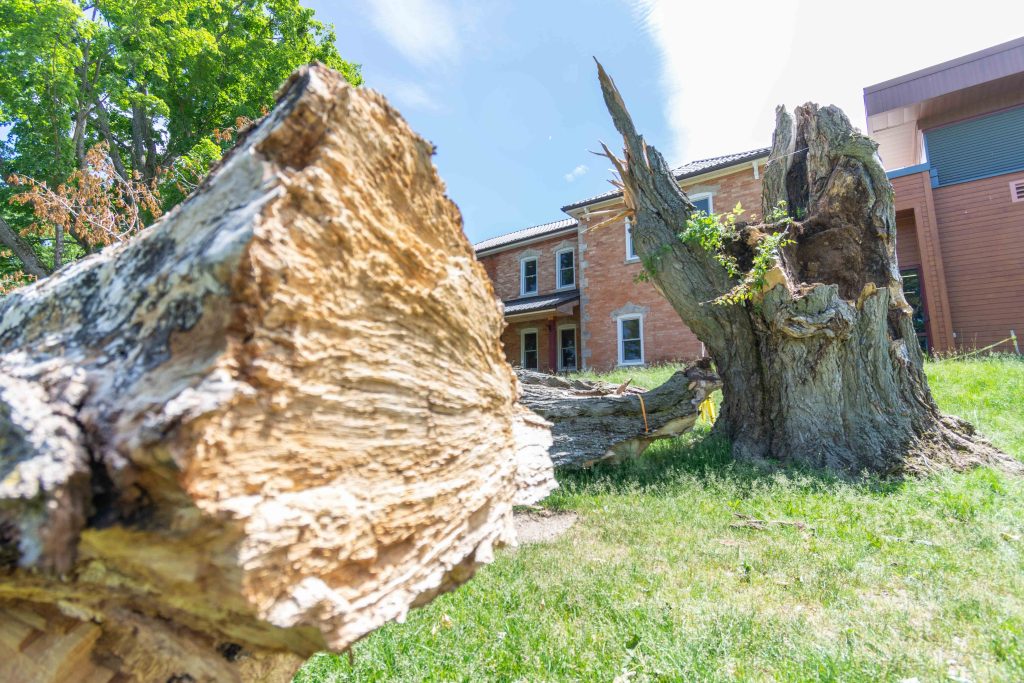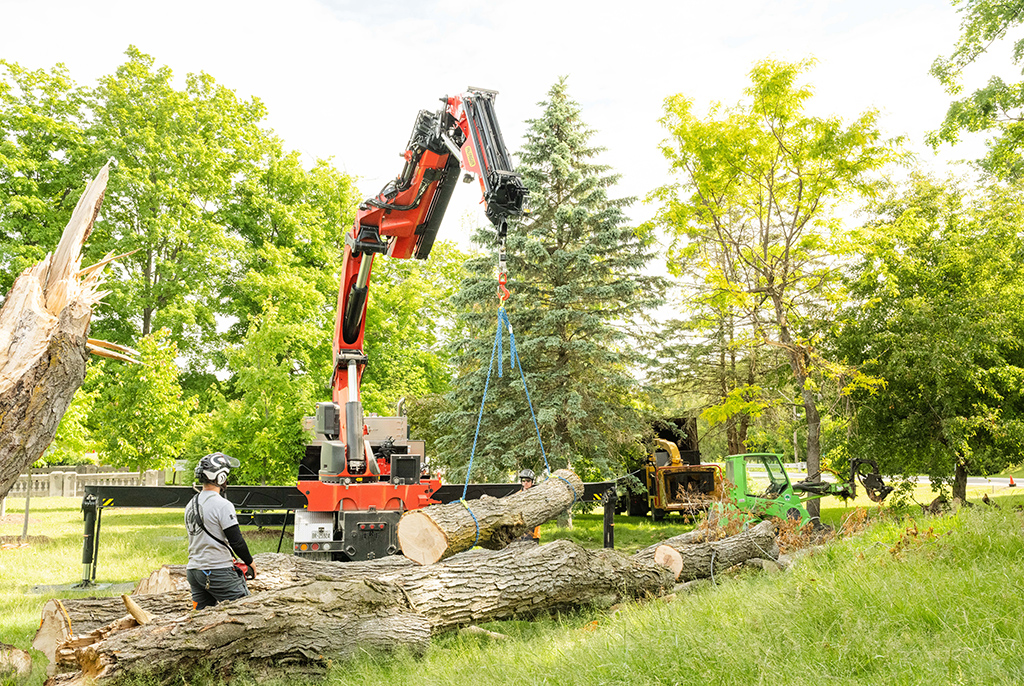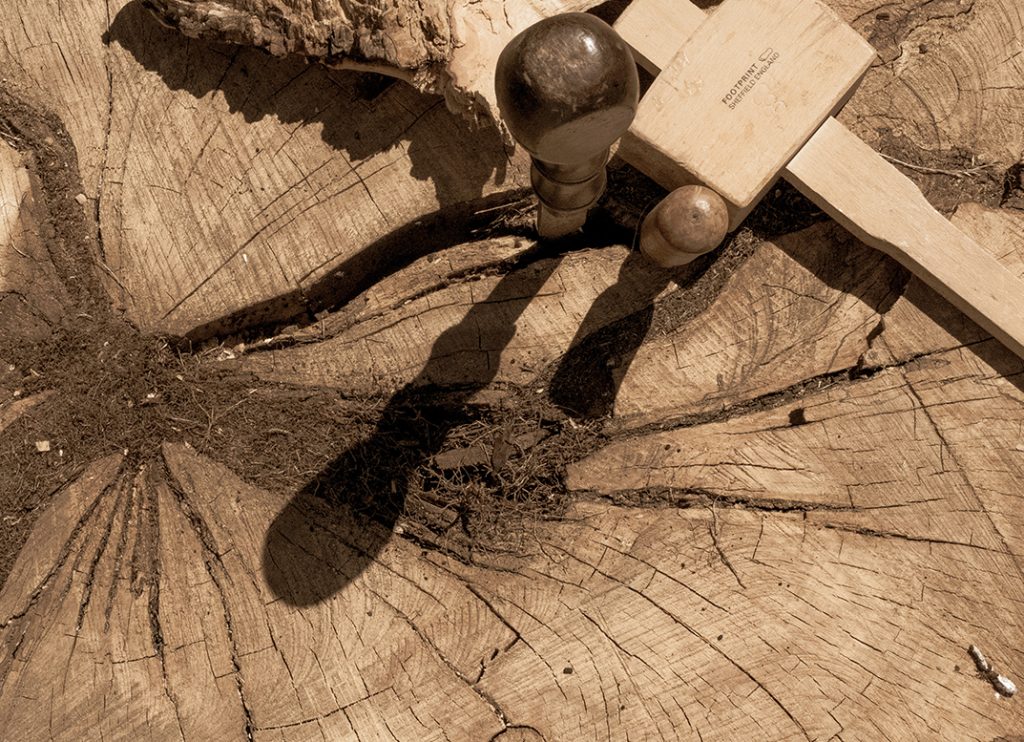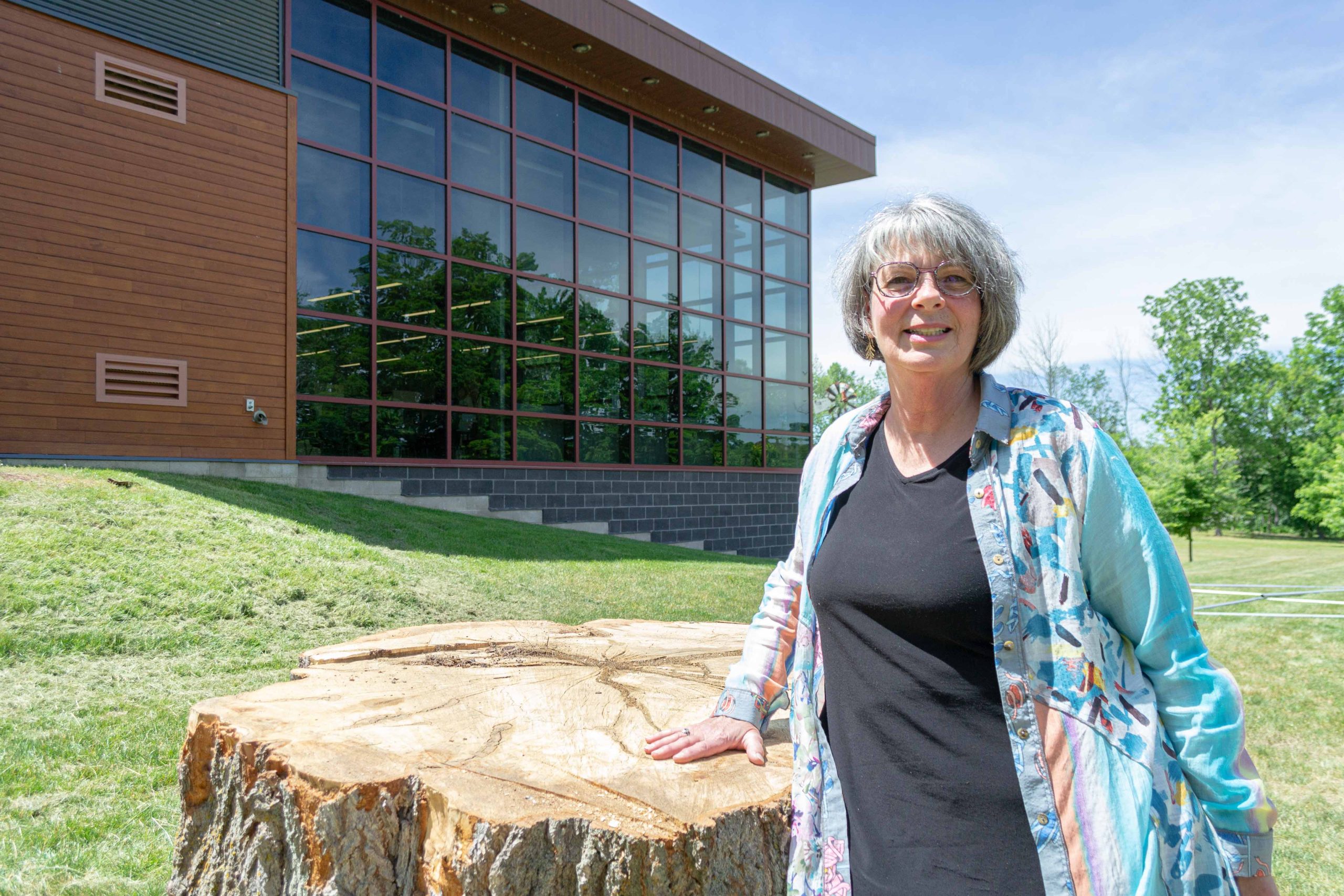HILLSBURGH — When Jennifer McKinnon first saw the fallen century-old maple tree, its decaying trunk persisting with toothy remnants jutting skyward, she at first felt saddened by the loss, she said, before her mind fired with “a million half-baked ideas.”
One thing was certain: the stump had to remain.
The old maple is believed to have withstood storms for over 130 years before being toppled by turbulent winds which lashed Wellington County on May 21.
With a penchant for local history, Erin county councillor Jeff Duncan said the tree, located on what is now county property supporting the Hillsburgh Library branch, predates what used to be a farmhouse thought to have been constructed in 1892.
Residents beckoned for chief librarian Rebecca Hine to do something to commemorate the mature maple and its past.
It would be McKinnon’s friend and local photographer, Melissa Auchincloss, who provided Hine the answer, suggesting McKinnon, a local woodworker, be comissioned to turn what could be salvaged from the tree in to public art.
“I said, ‘This is a perfect opportunity to create something positive, out of something that might not be so positive, and build community and connect the past [old] tree with the future of the community,” Auchincloss recalled.
Hine was happy to oblige and has given McKinnon a preliminary budget of $5,000.
“I’m really excited to have a local artist doing the work,” Hine remarked.
McKinnon has long wanted to tackle a project of this size and significance.

A tree with several trunks, believed to be at least 130 years old, splintered into pieces and collapsed to the ground behind Wellington County’s Hillsburgh library branch following high winds from a May 21 storm. Guelph-based JL’s Tree Service cut and removed the logs which Hillsburgh woodworker and artist Jennifer McKinnon is using to create public art, giving the fallen tree new life. (Photo by Jordan Snobelen)
The town, she says, needs public art to spark imaginations and serve as a local landmark for residents.
On a recent Friday morning, sitting beneath a shaded patio outside the library and not far from the stump, McKinnon said she wants the project to relate back to the community and teach people about wood and trees.
“How they withstand adversity and try to heal themselves, just like you or I,” she explained.
One of her favourite sections from the tree has a hollow centre, where the flesh has decayed, from end to end.
One could hardly be blamed for not giving the piece so much as a second glance before condemning it to flames, or as garden mulch.
As a tree heals itself, new tissue grows over the exposed wound, forming new, imperfect wood that looks perhaps unsightly and discardable.
But McKinnon prefers to work with imperfections.
After all, she says, she is the “furthest thing from perfect.”
Beneath the imperfections of twisted, eroded, knotty, warped tissue lies a woodgrain made possible only by destruction and regrowth.
***
McKinnon admits she doesn’t yet know what exactly will become of the collected wood, but said the stump will serve as the supporting platform.
Four, 20-foot-long trunks, each weighing between 3,200 and 4,000 pounds, along with several other smaller sections, sit atop skids in a lumber yard awaiting an arduous debarking process involving one whack of a mallet against a chisel at a time.
In this way, she will slowly remove the tree’s bark coat to reveal the canvas beneath, discovering what is truly possible once the grain is exposed.
Wouldn’t it be cool, she asked rhetorically, if the project connected past, present, and future.

Guelph-based JL’s Tree Service cut and removed the logs which Hillsburgh woodworker and artist Jennifer McKinnon is using to create public art, giving the fallen tree new life. (Photo by Melissa Auchincloss)
The past is of particular importance for McKinnon, with her familial roots tracing back to the early 1800s.
Her grandfather, Aaron Wheeler, is known to have constructed one of the earliest grist mills in Hillsburgh. His residence once stood at Mill Street and Trafalgar Road, where the Hillsburgh Community Centre now stands, according to McKinnon.
“I think it’s going to be somewhat abstract, with pockets of thoughtful things, whether it’s an old implement, or whether it’s some – ”
She doesn’t finish the thought, only offering a momentary glimpse into her mind’s eye.
McKinnon says she has “design intent,” but remains non-committal, wanting to avoid any chance of setting expectations too early.
She likens the woodworking process to stone carving; each strike of the mallet informs the next.
“You see something emerging from the tree,” she said. “It totally changes your direction, in a good way.”
***
McKinnon’s love of woodworking began nearly two decades ago when her father, John Evans, received a lathe as a retirement gift in 2003 and harangued his daughter into taking a four-hour wood turning course that would reform her artistic focus.
“About two hours in, I might as well have just thrown out my craft cupboard,” she said. “It was just an absolute passion.”
Woodturning pulls on the senses, she explained.
“The smell, the sound, the visual, the speed.”
Seeing the wood hurling around and spinning, she says, “makes you somewhat anxious.”
“When you engage, and you engage properly … it’s just a great experience,” she said.
McKinnon, her friend Auchincloss said, has an “incredible ability” to work in three dimensions.
When Auchincloss says this, McKinnon pulls out an iPad, showing photos she took capturing different vantage points of where the tree would be seen from within the library.
“I want to be able to have this piece work from as many angles as I can get it to work,” she explains.
“So as you move through the space, you get closer and you see that, and then you see this, and then it’s gone, and then if you’re actually in this section of the library, this is what you’re seeing,” she said, swiping through photos, indicating how the finished project would be seen through the library’s windows.
“Nobody else in the world will care about this, but for some reason, I do,” she said.
***
One of the biggest challenges McKinnon will face is ensuring the long-term stability of the porous, organic material so it survives well beyond her years for future Hillsburgh residents to see and enjoy.
Given the size of the wood and how long it would take to kiln dry, McKinnon intends to finish the project green.
But that means anticipating checking – a splitting of wood at its exposed end, caused by moisture escaping faster from the end grain than it does from the long grain – and incorporating the defect into her design.
Individual pieces can also be fashioned and formed in such a way to promote water run off from the wood.
“I really have to think about design intent and how to maximize longevity through design,” she said.

Tools of the trade photographed on the Hillsburgh tree stump. (Photo by Melissa Auchincloss)
Working horizontally will also be a first for McKinnon – one cannot easily upright a 20-foot-tall tree trunk with a 30-inch base.
“It’s all intimidating; I haven’t worked in this big of a manner,” she said.
“People might think I’m actually off my rocker, but I’ve always wanted to do something like this.”
Months will go by before McKinnon’s work nears something resembling completion, and much should be expected to change along the way.
She loosely suggests the project could be finished by springtime – an ambitious goal requiring other projects be put on pause.
Later that afternoon, McKinnon returned in clothes more suitable to work and hollowed out bark inclusions embedded in the stump, filled cracks with expanding foam, and coated the top of the stump with a sealant, preserving the integrity of the end grain – marking the first steps of what could be an extravagant display of public art connecting the community to its past, long into the future.




